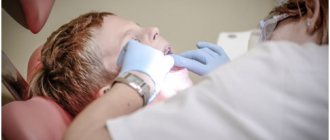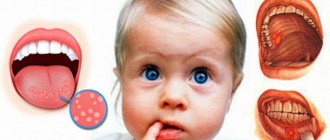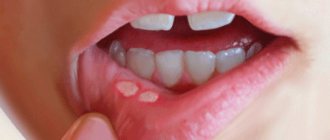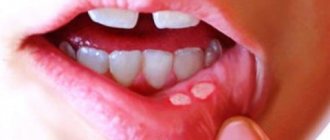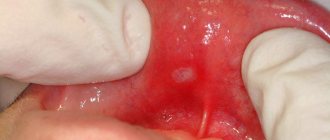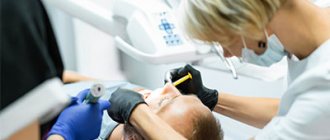From this article you will learn:
- how to treat aphthous stomatitis in children,
- symptoms and treatment of aphthous stomatitis in adults,
- list of effective drugs.
The article was written by a dentist with more than 19 years of experience.
Aphthous stomatitis is a disease in which one or more round ulcerations appear on the oral mucosa, which are covered with a necrotic coating of a gray or yellowish tint. Such ulcers (synonymous with aphthae) are not the result of acute infections, and therefore are not contagious, but nevertheless, such damage to the mucous membrane will require specific therapy.
According to statistics, up to 20% of the population suffers from this form of stomatitis. Young children, as well as adults aged 20 to 30 years, are especially susceptible to this disease. In people of more mature age, there is a dependence: the higher the age, the less likely it is to develop. Aphthous stomatitis has a code according to ICD 10 - K12.0. Below you can see what this disease looks like in children and adults.
Aphthous stomatitis in children: photo
Aphthous stomatitis: photos in adults
The most important thing in treating stomatitis is to first correctly determine its form. Indeed, depending on its form, and it can be either herpetic or aphthous stomatitis, treatment for both adults and children will be completely different. Therefore, if you are not very sure of the diagnosis, it is best to familiarize yourself with the symptoms of both forms before starting treatment.
Causes of stomatitis
In children, as in adults, stomatitis can be caused by viruses, fungi, bacteria, allergies and injuries. About six months after birth, the child loses the immunity received from the mother, the protective power of the immune system changes, and the child’s body becomes more susceptible to infections. The oral mucosa in children is more delicate and easier to injure; children also more often “bite” their cheeks after dental treatment due to a temporary loss of sensitivity after anesthesia, which causes traumatic stomatitis.
Children are not always motivated to brush their teeth, so poor hygiene can also cause stomatitis.
With the following diseases, stomatitis is observed in children much more often: chronic tonsillitis, diabetes mellitus, heart defects, chronic hepatitis.
Treatment
To begin to treat the pathology, contact of the mucous membrane with the irritant should be excluded. After this, correct drug therapy with antihistamines is prescribed. Treatment of allergic stomatitis includes treatment of mucous tissues with antiseptics, painkillers, and healing substances. Activities depend on the provoking factors that led to the anomaly. Doctors recommend that patients follow a diet, change mouthwash, brush and toothpaste. The most commonly prescribed drugs are clarotadine, suprastin, fenistil, vitamins PP, C, group B, and folic acid.
Local treatment of the oral cavity with antiseptics is useful. According to indications, enzyme preparations and corticosteroids are prescribed. Among the healing mixtures, Kamistad gel and sea buckthorn oil are used. Orthopedists can prescribe for patients a replacement of an artificial crown, filling, brace system, as well as the base of the prosthetic structure. The disease, which occurs in a mild form, is treated by rinsing with solutions to disinfect the mouth. In severe pathologies, intravenous medications may be required. Therapy for the initial stage of the disease requires 2-3 weeks, for advanced stages - from 20 to 30 days or longer.
Classification of HRAS (chronic recurrent aphthous stomatitis)
| CLASSIFICATION | A COMMENT | ||
| classification: | According to the degree of damage to the mucous membrane: | a comment: | 1) Superficial (catarrhal, fibrinous) 2) Deep (ulcerative, necrotic) |
| classification: | According to the clinical course: | a comment: | 1) acute 2) chronic |
All types of stomatitis occur in children, but the most common are: herpetic, candidal and traumatic stomatitis.
Acute herpetic stomatitis
It occurs most often, and mainly affects children from 10 months to 3 years.3 The appearance of rashes is preceded by inflammation of the lymph nodes.
With a mild form
In acute herpetic stomatitis, the temperature rises to 37-37.5°C, the general condition is satisfactory, slight swelling and redness may occur on the gums, then up to six blisters appear, which burst with the formation of painful aphthae surrounded by a red rim.
Afta is a round-shaped erosion. Aphthae may merge together. The rash appears once, and after 1-2 days the erosion gradually heals.
Moderate form
Acute herpetic stomatitis is characterized by deterioration of the child’s well-being, weakness, and headache. The child is capricious, has no appetite, the lymph nodes are enlarged and painful, the temperature rises to 38-39°C, the symptoms resemble ARVI. The oral mucosa is swollen, reddened, rashes appear (bubbles, then erosions) of 10-15 pieces, and often there are rashes on the face. Salivation increases, and gingivitis appears (inflammation of the gums, accompanied by bleeding). The rash may appear several times, i.e. after the old ones heal, new ones appear. Healing of erosions takes up to 4-5 days. Bleeding gums and swollen lymph nodes persist for some time after the erosions have healed.
Severe form
It begins as an acute respiratory viral infection, there is pain in the muscles, joints, tachycardia and bradycardia (increased and slow heartbeat), and nosebleeds may even be observed. In this form, the temperature is high up to 40°C, gingivitis is pronounced, the mucous membrane is bright red, swollen, the child’s lips are dry, the mucous membrane of the eyes is swollen, reddened. The rashes constantly appear again, their number can reach 100. Rashes often appear around the mouth, on the eyelids, on the mucous membranes of the eyes, between the fingers, on the earlobes. Simple gingivitis turns into ulcerative (a more severe form of gum inflammation, with the formation of ulcers), salivation increases, and bad breath appears. Recovery is long and hospitalization is often required.
General therapeutic recommendations
- During treatment, it is important to exclude aphtha-like ulcerations, which are associated with systemic diseases.
- The vast majority of patients are healthy people.
- Successful therapy requires an accurate diagnosis and control of provoking etiological factors.
- Treatment of the disease should pursue the following goals:
- elimination of pain and discomfort,
- reduction in illness duration
- relapse prevention.
Recommended Treatments
- Control over possible provoking etiological factors
- Patients should be encouraged to keep a food diary to identify potential triggers associated with aphthous changes. Patients should avoid minor injuries to the oral mucosa. Stress factors and hormonal changes in women also need to be taken into account. A gluten-free diet may be helpful in controlling lesions even in the absence of systemic disease.
Local events
Local interventions can reduce pain and shorten the duration of the disease, but they do not prevent relapses.
Local anesthetics such as 2% viscous lidocaine (lignocaine), benzocaine and benzydamine hydrochloride may relieve pain only for a short period. Recently, 5% amlexanos in the form of an oral paste, as well as 3% diclofenac based on 2.5% hyal damage, have been used to reduce pain. Topical tetracyclines have been used with partial success. In this case, the capsule (250 mg) is dissolved in 30 ml of water, and then 5 ml of the solution is used for rinsing 4-6 times a day. Treatment is repeated for 3-5 days. Many other anti-inflammatory and antimicrobial agents (chdorgexidine, listeria) have been used, but with unsatisfactory results. The best topical preparations are 1% triamcinolone acetonide in an adhesive base (Orabace) or 0.05% clobetasol propionate in gel form (Temovate) - applied to the ulcer 6 times a day for 4-6 days. Intralesional injections of triamcinolone acetonide or betamethasone dipropionate and potassium phosphate can be used successfully only for large aphthous ulcers.
System measures
Systemic corticosteroids (prednisone, betamethasone) in average doses of 20-30 mg or 2-3 mg, respectively, for 4-8 days are effective for large ulcers or herpetiform ulcerations. With repeated episodes, as well as in cases where new ulcers appear before old ones heal, systemic medications can help prevent new lesions.
Our experience shows that 20 mg of prednisone or 2 mg of betamethasone dipropionate for 10-15 days, followed by injections of betamethasone propionate and potassium phosphate for 2 months. can significantly increase the intervals between relapses. Long-term use of systemic corticosteroids is contraindicated due to side effects.
In severe cases with a high frequency of relapses and in patients with HIV infection, use thalidomide at a dose of 100-300 mg/day for 2-3 months. can lead to complete remission of ulcers for a long period. However, teratogenicity and polyneuropathy preclude routine use of thalidomide.
Clinicians should remember that safe long-term prophylaxis is not yet available.
Alternative and experimental treatments
In severe cases, various other systemic drugs have been used with conflicting results. These drugs include:
- dapsone 25-50 mg/day for several weeks;
- levamisole hydrochloride;
- azathioprine;
- colchicine;
- interferon;
- cyclosporine;
- pentoxifylline;
- acyclovir;
- etretinate.
Enteroviral vesicular stomatitis (arm - leg - mouth)
Caused by enteroviruses. It also occurs in adults, but in 95.7% of cases children are affected.6 It is characterized by seasonal occurrence (summer - autumn) and group incidence.4 It is observed mainly in children under 10 years of age. Vesicular stomatitis is contagious, so it is recommended to use separate utensils and hygiene products. Characteristics for this disease: temperature 37.5-38, weakness, headache, muscle pain, rash on the palms, soles, as well as blisters on the hard palate and pharynx, which then turn into erosions that are almost not painful.
Acute pseudomembranous candidal stomatitis (thrush)
Acute pseudomembranous candidal stomatitis (thrush) occurs:
- Light shape
- Medium-heavy forms
- Severe form
The main symptom of the disease is a white or yellow coating.
With a mild form
The plaque is located in islands, most often on the tongue and cheeks. Children are restless, sleep poorly, and suck the breast sluggishly. Older children may complain of a burning sensation. The plaque is easily removed; underneath there is a bright red mucous membrane. The disease lasts no longer than 7 days.5
Moderate form
The plaque is located on the cheeks, tongue, hard palate, and mucous membranes of the lips. Under the plaque, erosions form, which sometimes bleed. The plaque is more difficult to remove. Lymph nodes are sometimes enlarged and painful. The duration of the disease is 10-15 days, there are relapses.
Moderate form
The plaque is dirty gray, almost cannot be removed, and is located on the tongue, cheeks, soft palate, tonsils, pharynx, and mucous membranes of the lips. Cheilitis appears in the corners of the mouth - inflammation of the lips. The oral mucosa is dry and inflamed. The child’s health is impaired, the child refuses to eat, and the temperature rises. Lesions in the genital area, neck folds, and between the fingers are also common. The disease is long-term, with frequent relapses.
Prevention
To prevent allergic stomatitis, you should regularly clean your mouth in the dentist's office, where bacterial plaque will be removed. At home, patients must carefully follow all the dentist’s instructions, perform high-quality oral hygiene procedures, and promptly treat caries and gum disease. It is necessary to adjust prosthetic systems in a timely manner, and if necessary, they must be changed. For therapeutic and orthodontic treatment, only hypoallergenic materials should be used.
Pathologies at an early stage are easier to overcome. The duration of treatment for catarrhal pathology does not exceed 15 days. In severe cases, therapy is carried out for a long time. Prevention is impossible without good hygienic oral care. You should clean your chewing organs twice a day, rinse your mouth after every meal, get rid of dental and gum diseases in a timely manner, and visit the dentist twice a year. If the body is negatively affected by seasonal changes, it is necessary to protect the mucous membranes of the oral and nasal cavities from the penetration of antibodies into the body. To do this, the doctor will prescribe a barrier agent.
Bacterial stomatitis in children
Necrotizing ulcerative stomatitis is more common in weakened children and is caused by fusobacteria and spirochetes. May be a sign of periodontal disease (progressive destruction of periodontal tissue). It is characterized by the appearance of painful ulcers, weakness, gingivitis (inflammation of the gums), enlarged and painful lymph nodes, difficulty eating, speaking, and bad breath.
Often, erosions in traumatic stomatitis can become infected through dirty hands, toys and other objects, then bacterial stomatitis develops, so it is important to pay attention to antiseptic treatment.
Traumatic stomatitis in children
A specific form of traumatic stomatitis in children is Bednar's aphthae . This is a traumatic erosion of the oral mucosa. In children, unlike adults, the mucosal epithelium consists not of four layers, but of two, so it is easily injured. The cause may be early teething, a rough nipple from the mother, or a long nipple on the bottle. Erosion is most often located in the middle of the palate or opposite the cutting edge of the teeth. The child begins to refuse food, cries, and sleeps poorly.
Traumatic stomatitis also occurs in children when wearing braces. Erosions have uneven edges, are painful, and are usually located on the mucous membrane of the cheeks and lips, less often on the tongue.
Pediatric stomatitis
Treatment of mild herpetic stomatitis
Thanks to timely consultation with a doctor, the inflammatory phenomena subside within a week.
Antiseptic rinses (spray irrigation)
Antiseptic solutions destroy pathogenic microflora of the oral cavity, protecting against the addition of a secondary infection. Your doctor may prescribe rinsing 3-4 times a day for 15 minutes. Convenient to use spray irrigation when the child refuses rinsing. After using the antiseptic solution, you should refrain from eating for about an hour.
Pain relieving anti-inflammatory gel
Anesthetic gels contain an anesthetic solution. They are used to treat painful erosions before eating. The gel is applied for 5 minutes to the surface of the erosion in a thin layer.
Keratoplasty (drugs to stimulate mucosal healing)
After the inflammatory phenomena subside, oil solutions of vitamins are used for external use. They improve metabolic processes in the epithelium, which accelerates the healing of erosions. Sterile gauze wipes soaked in an oil solution are applied to the erosions for 7-10 minutes. After this, you should also refrain from eating so as not to remove the formed film from the erosion.
Treatment for the presence of lesions on the skin around the mouth and the red border of the lips
After the bubbles open, crusts form. Their mechanical removal provokes the formation of other bubbles. Crusts on the lips make it difficult to speak and eat. Violation of their integrity opens the bleeding mucosa.
Therefore, crusts must be treated with solutions of proteolytic enzymes to soften and remove them. Oil solutions of vitamins are also used to heal the skin and mucous membrane underneath. Lips are treated with moisturizing balms to prevent them from drying out.
Special food and feeding
Food should not further irritate the inflamed mucous membrane, therefore it is recommended:
- make food liquid, at room temperature;
- exclude sour, salty foods;
- Before eating, treat erosions with anesthetic gel.
Oral hygiene for stomatitis
Maintaining hygiene is one way to combat re-infection of the mucous membrane. Also, all treatment solutions must be applied to a clean surface. After each meal, it is necessary to rinse the mouth with plain water to prevent the development of pathogenic microflora.
The herpes simplex virus is contagious and can enter a child’s body through environmental objects (shared dishes, toys). Therefore, it is necessary to treat them and protect a child with herpetic stomatitis from contact with other children.
Drug-induced stomatitis
Occurs when there is an allergy to a drug. Often, allergies can occur to antibacterial, antimicrobial drugs, vaccines, iodine. The mucous membrane is red, swollen, the lips and tongue also often swell, blisters appear, which burst, leaving erosion. The gums are inflamed and bleed when touched. General manifestations are possible, such as urticaria, nausea, vomiting. In severe cases, anaphylactic shock occurs (an emergency condition manifested by decreased blood pressure, shortness of breath, fainting, suffocation), Quincke's edema (an atypical reaction of the body, manifested by rapid and severe swelling)
Both conditions are extremely dangerous and require immediate action and calling an ambulance!
Prevention of stomatitis in children
In children's groups, infections spread especially quickly. Therefore, if a child is infected with the herpes virus, he needs to stay at home until he recovers. Children who have been in contact with sick people should use antiviral ointments for 5 days.
If a pregnant woman has herpes or candidiasis, she should treat it before giving birth. If you have the herpes virus during the period of illness, you should use separate utensils, do not kiss children, and wear a mask.
Kindergartens and other preschool institutions must be cleaned and objects, including toys, must be treated with disinfectants.
To avoid allergic reactions, you should seek help from an allergist to identify existing allergies.
It is worth preventing a decrease in immunity; hardening works especially well in childhood. It is worth limiting your intake of fast carbohydrates, because... they create a favorable environment for the development of candidiasis. An important point is the proper nutrition of the child; regular intake of vitamins, especially vitamin C, is essential.
Tantum® Propolis
For children over 14 years of age , you can use Tantum® Propolis lozenges; they contain a lot of vitamin C, which will strengthen the immune system, and propolis has an anti-inflammatory effect, preventing the occurrence of infections.7
Find out more
Prevention of Bednar's aft is preparing the breasts for feeding, using special creams to soften the skin, prevent cracks, and it is also worth choosing the right bottle. In case of injury due to braces, you need to use orthodontic wax; here it is important to prevent the wounds from becoming infected, so it is better to treat them with antiseptic solutions and sprays.
Tantum® Verde spray will relieve pain at the site of injury and its antiseptic effect will prevent infection.8,9
Aphthous stomatitis - symptoms and treatment
The doctor’s task in the treatment of aphthous stomatitis is to achieve stable remission, or clinical or complete recovery.
In the treatment of this disease, an integrated approach is extremely important, which should include general and local therapy and competent selection of medications. Their choice depends on the form of stomatitis and the severity of the disease.
One of the stages is local treatment. It involves treating aphthae with antiseptic and healing agents, carrying out antiseptic rinses and using anti-inflammatory gels. Today, the most effective and efficient medicines are:
- "Miramistin" - used for antiseptic treatment of the oral cavity.
- "Cholisal" - is used at the initial stage of the disease to eliminate pain.
- "Kamistad", "Trasilol", clobetasol - anti-inflammatory ointments with an anesthetic.
- "Diphenhydramine" - prescribed for allergic reactions.
- “Tantum Verde”, “Hexoral” are antibacterial agents recommended for secondary infection.
- "Stomatofit-A" is an anesthetic balm to combat canker sores.
- “Solcoseryl-gel” is an epithelializing agent, used after the disappearance of ulcers [10].
During exacerbations, enzymes such as trypsin, chymotrypsin and RNase must be applied topically to remove necrotic plaque from the surfaces of erosions. The process of epithelization is significantly accelerated by such agents as solutions of citral, vitamin C and P, preparations with Kalanchoe and propolis juice. The use of corticosteroid ointments prevents further development of aphthae and speeds up the healing process.
When treating stomatitis, you should pay attention to strengthening the immune system and the general condition of the body, this allows you to more successfully fight the disease.
It is recommended to take antihistamines internally - clemastine, loratadine, fexofenadine, since in many cases the causes of aphthous stomatitis can be food allergens or components of hygiene products (such as sodium lauryl sulfate). To eliminate swelling and inflammation, it is recommended to use desensitizing drugs - quifenadine and histamine with immunoglobulin. If the body’s sensitivity to a specific microbial agent is detected, then specific desensitization is used. According to indications, antiviral drugs and an antiherpetic vaccine are prescribed.
With the development of aphthous stomatitis, it is important to take a course of vitamins based on the doctor’s instructions. It is recommended to consume vitamins B and C, which effectively influence the healing process. At the same time, you need to understand that uncontrolled intake of vitamins can lead to various consequences: from intoxication and intestinal disorders to the development of serious chronic diseases.
Sometimes immunomodulators and immunoprotectors are prescribed, especially in the presence of chronic recurrent aphthous stomatitis. Immunomodulators can speed up the healing process by strengthening the body’s defenses, so with their use it is possible to quickly achieve complete remission of severe lesions [14]. It is recommended to include phonophoresis, electrophoresis and laser therapy in the treatment complex, since, according to some studies, these procedures relieve pain and promote faster healing [15].
With aphthous stomatitis, the inflamed mucosa reacts sharply to food and temperature irritants, so during treatment and during remissions it is important to follow a hypoallergenic diet. You should also avoid rough, traumatic and acidic foods, which can increase signs of epithelial damage (crackers, hard bread, sour juices, carbonated drinks, sauces, citrus fruits). You should not drink alcohol in any form [6].
